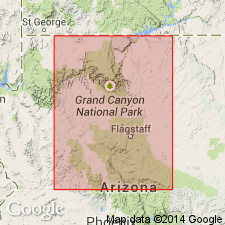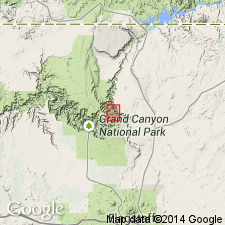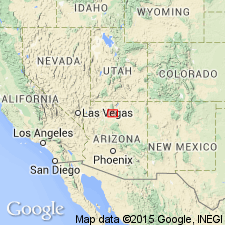
- Usage in publication:
-
- Tanner Member
- Modifications:
-
- First used
- AAPG geologic province:
-
- Plateau sedimentary province
Summary:
First use of the Tanner Member of the Galeros Formation of the Chuar Group. Age is late Precambrian.
Source: GNU records (USGS DDS-6; Menlo GNULEX).

- Usage in publication:
-
- Tanner Member
- Modifications:
-
- [Principal reference]
- Dominant lithology:
-
- Shale
- Dolomite
- AAPG geologic province:
-
- Plateau sedimentary province
- Southern Rocky Mountain region
Summary:
Pg. 1244 (table 1), 1245, 1247-1248, geol. map (fig. 1), columnar section (fig. 2). Tanner Member of Galeros Formation of Chuar Group. Is basal member of Galeros Formation (new). Total thickness 640 feet (195 m). Upper 580 feet, chiefly shale, includes CHUARIA near top. Appears = Walcott's lower division 9 of Chuar terrane [USGS Ann. Rpt. 14, p. 508-509, 1894], and Hinds' division 1 and part of 2 of Chuar Group [Carnegie Inst. Washington Pub. 463, p. 105-106, 1936]. Lower 60 feet, massive coarsely crystalline dolomite. The dolomite forms the topmost ledge of the cliffs overlooking the mouth of Basalt Canyon and Tanner Rapids. Appears = Walcott’s division 1a of Unkar terrane [USGS Ann. Rpt. 14, p. 510, 511-512, 1894]. The Tanner underlies basal stromatolitic limestones of Jupiter Member (new) of Galeros Formation. Unconformably(?) overlies sandstones of Nankoweap Group; contact is not easily accessible. Fossils. [See also T.D. Ford and W.J. Breed, 1973, The problematical Precambrian fossil CHUARIA: Palaeontology, v. 16, pt. 3, p. 535-550.] Age is late Precambrian.
Type section: Tanner section A, in cliffs of Basalt Canyon above Tanner Rapids, [approx. Lat. 36 deg. 06 min. 45 sec. N., Long. 111 deg. 50 min. 45 sec. W., Desert View 7.5-min quadrangle], eastern Grand Canyon, Grand Canyon National Park, Coconino Co., northern AZ.
Named from Tanner Rapids, Colorado River [labeled Tanner Canyon Rapids on post-2000 topographic maps; approx. Lat. 36 deg. 06 min. 12 sec. N., Long. 111 deg. 50 min. 06 sec. W., Desert View 7.5-min quadrangle], eastern Grand Canyon, Grand Canyon National Park, Coconino Co., northern AZ.
[Additional locality information from USGS historical topographic map collection TopoView, accessed on October 7, 2024.]
Source: Publication; supplemental information from US geologic names lexicon (USGS Bull. 1520, p. 303).

- Usage in publication:
-
- Tanner Member*
- Modifications:
-
- Adopted
- AAPG geologic province:
-
- Plateau sedimentary province
Summary:
Tanner Member of the Galeros Formation of the Chuar Group of Ford and Breed (1973) is adopted as the Tanner Member of the Galeros Formation of the Chuar Group of the Grand Canyon Supergroup. Age is late Precambrian.
Source: GNU records (USGS DDS-6; Menlo GNULEX).

- Usage in publication:
-
- Tanner Member*
- Modifications:
-
- Age modified
- AAPG geologic province:
-
- Plateau sedimentary province
Summary:
Age of the Tanner Member of the Galeros Formation is modified from late Precambrian to: Proterozoic Y.
Source: GNU records (USGS DDS-6; Menlo GNULEX).

- Usage in publication:
-
- Tanner Member*
- Modifications:
-
- Age modified
- AAPG geologic province:
-
- Southern Rocky Mountain region
Summary:
Is the basal member of Galeros Formation of Chuar Group of Grand Canyon Supergroup. Unconformably overlies Nankoweap Formation. Is 156 m thick. Age designation of Proterozoic Y changed to Late Proterozoic, the term applied to rocks younger than 900 Ma and older than 570 Ma. Change in age designation made to Galeros and its Tanner, Jupiter, Carbon Canyon, and Duppa Members in the Southern Rocky Mountain region of northern AZ. Columnar section.
Source: GNU records (USGS DDS-6; Denver GNULEX).
For more information, please contact Nancy Stamm, Geologic Names Committee Secretary.
Asterisk (*) indicates published by U.S. Geological Survey authors.
"No current usage" (†) implies that a name has been abandoned or has fallen into disuse. Former usage and, if known, replacement name given in parentheses ( ).
Slash (/) indicates name conflicts with nomenclatural guidelines (CSN, 1933; ACSN, 1961, 1970; NACSN, 1983, 2005, 2021). May be explained within brackets ([ ]).

